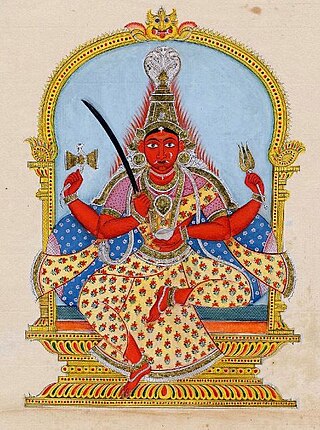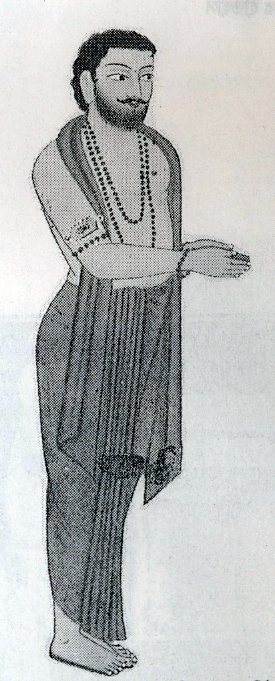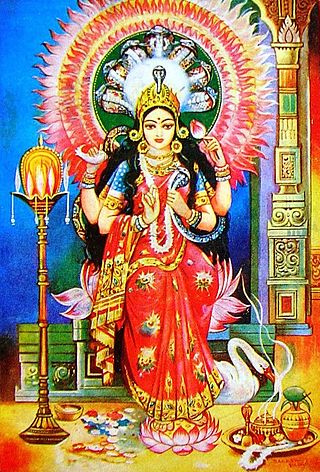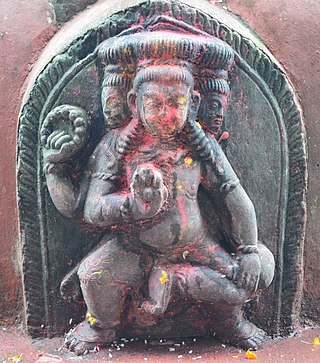
In Hinduism, the goddess Tara is the second of the Dasa (ten) Mahavidyas or "Great Wisdom goddesses", and is a form of Adishakti, the tantric manifestation of Parvati. Her most famous centre of worship is the temple and the cremation ground of Tarapith in West Bengal, India. Her three most famous forms are Ekajaṭā, Ugratara, and Nīlasarasvatī.

Mariamman, often abbreviated to Amman, is a Hindu goddess of rain, predominantly venerated in the rural areas of South India. Her festivals are held during the late summer/early autumn season of Ādi throughout Tamil Nadu and the Deccan region, the largest being the Ādi Thiruviḻa. Her worship mainly focuses on bringing rains and curing diseases like cholera, smallpox, and chicken pox. Mariamman is worshipped in accordance with local traditions such as Pidari or the Gramadevatai. She is considered as a guardian deity by many South Indian village-dwellers.

Shaktism is one of several major Hindu denominations, wherein the metaphysical reality is considered metaphorically a woman and Shakti (Mahadevi) is regarded as the supreme godhead. It includes many goddesses, all considered aspects of the same supreme goddess. Shaktism has different sub-traditions, ranging from those focused on most worshipped Durga, gracious Parvati to that of fierce Kali.

Durga Puja, also known as Durgotsava or Sharodotsava, is an annual Hindu festival originating in the Indian subcontinent which reveres and pays homage to the Hindu goddess Durga and is also celebrated because of Durga's victory over Mahishasur. It is celebrated all over the world by the Hindu Bengali community but it is particularly popular and traditionally celebrated in the Indian states of West Bengal, Bihar, Assam, Tripura, Odisha, Jharkhand, Uttar Pradesh and the country of Bangladesh. The festival is observed in the Indian calendar month of Ashwin, which corresponds to September–October in the Gregorian calendar. Durga Puja is a ten-day festival, of which the last five are of the most significance. The puja is performed in homes and public, the latter featuring a temporary stage and structural decorations. The festival is also marked by scripture recitations, performance arts, revelry, gift-giving, family visits, feasting, and public processions. Durga Puja is an important festival in the Shaktism tradition of Hinduism. Durga Puja in Kolkata has been inscribed on the Intangible cultural heritage list of UNESCO in December of 2021.

Sadhak Rāmprasād Sen was a Hindu Shakta poet and saint of eighteenth century Bengal. His bhakti poems, known as Ramprasadi, are still popular in Bengal—they are usually addressed to the Hindu goddess Kali and written in Bengali. Stories of Ramprasad's life typically include legends and myths mixed with biographical details.

Chandi or Chandika is a Hindu deity. Chandika is another form of Mahadevi, similar to Durga. Chandika is a powerful form of Mahadevi who manifested to destroy evil. She is also known as Kaushiki, Katyayani, AsthadasabujaMahalakshmi and Mahishasuramardini.

East Bengal was a non-contiguous province of the Dominion of Pakistan. Geographically part of the Bengal region, East Bengal existed from 1947 until 1955, when it was renamed East Pakistan. Today, the area is an independent country, Bangladesh. With its coastline on the Bay of Bengal, it bordered India and Myanmar. It was located close to, but did not share a border with, Nepal, Tibet, the Kingdom of Bhutan and the Kingdom of Sikkim. Its capital was Dacca, now known as Dhaka.

Sheetalalit. '"coolness"', also spelled as Shitala and Seetla, is a Hindu goddess venerated primarily in North India. She is regarded to be an incarnation of the goddess Parvati. She is believed to cure poxes, sores, ghouls, pustules, and diseases, and most directly linked with the disease smallpox. Sheetala is worshipped on Tuesday Saptami and Ashtami, especially after Holi during the month of Chaitra. The celebration of the goddess Sheetala on the seventh and eighth day of the Hindu month is referred to as the Sheetala Saptami and Sheetala Asthami, respectively.

Tarapith is a 13-century Hindu temple in Chandipur village Rampurhat II CD block in Rampurhat subdivision of Birbhum district of the Indian state of West Bengal, known for its Tantric temple and its adjoining cremation grounds where sādhanā are performed. The Tantric Hindu temple is dedicated to the goddess Tara, a fearsome Tantric aspect of the Devi, the chief temples of Shaktism. Tarapith derives its name from its association as the most important centre of Tara worship.

Mangal-Kāvya is a group of Bengali religious texts, composed more or less between 13th and 18th centuries, notably consisting of narratives of indigenous deities of rural Bengal in the social scenario of the Middle Ages. The Mangal-Kāvyas usually give prominence to a particular deity amalgamated with a Vedic or Hindu mythological god and the narratives are usually written in the form of verses.

Manasa is a Hindu goddess of snakes. She is worshipped mainly in Bihar, Bengal, Jharkhand, Lower Assam and other parts of northeastern India and in Uttarakhand, chiefly for the prevention and cure of snakebite, and also for fertility and prosperity. In Hindu mythology, Manasa is the sister of the first two naga kings, Shesha and Vasuki, and the wife of Sage Jaratkaru. She is the mother of the sage Astika. She is also known as Vishahari, Nityā (eternal) and Padmavati.
Chandbibi (চাঁদবিবি) is a Hindu goddess and folk deity in Bengal, worshipped in conjunction with the goddesses Oladevi, Ajgaibibi, Jholabibi, Bahadabibi, Jhetunebibi and Asanbibi.
Jhetunebibi is a Hindu goddess and folk deity in Bengal, worshipped in conjunction with the Goddesses Oladevi, Ajgaibibi, Chandbibi, Bahadabibi, Jholabibi and Asanbibi.

Annapurna, Annapurneshwari, Annada or Annapoorna is a manifestation of Parvati and is known as the Hindu Goddess of food and nourishment. Worship and offering of food are highly praised in Hinduism, and therefore, the Goddess Annapurna is regarded as a popular deity. She is a manifestation of the Goddess Parvati, the wife of Shiva, and is eulogized in the Annada Mangal, a narrative poem in Bengali by Bharatchandra Ray. The Annapurna Sahasranam is dedicated to the Goddess and praises her one thousand names, while the Annapurna Shatanama Stotram is dedicated to her 108 names.

Kali, also referred to as Mahakali, Bhadrakali, and Kalika, is a Hindu goddess who is considered to be the goddess of ultimate power, time, destruction and change in Shaktism. In this tradition, she is considered as a ferocious form of goddess Mahadevi, the supreme of all powers, or the ultimate reality. She is the first of the ten Mahavidyas in the Hindu tantric tradition.

The practice of Hindu animal sacrifice is mostly associated with Shaktism, and in currents of folk Hinduism strongly rooted in local popular or tribal traditions. The practice declined during the formation of Hinduism as Hindu scriptures like the Puranas and the Bhagvad Gita forbid animal sacrifice.

Shashthi or Shashti is a Hindu goddess, venerated in Nepal and India as the benefactor and protector of children. She is also the deity of vegetation and reproduction and is believed to bestow children and assist during childbirth. She is often pictured as a motherly figure, riding a cat and nursing one or more infants. She is symbolically represented in a variety of forms, including an earthenware pitcher, a banyan tree or part of it or a red stone beneath such a tree; outdoor spaces termed shashthitala are also consecrated for her worship. The worship of Shashthi is prescribed to occur on the sixth day of each lunar month of the Hindu calendar as well as on the sixth day after a child's birth. Barren women desiring to conceive and mothers seeking to ensure the protection of their children will worship Shashthi and request her blessings and aid. She is especially venerated in eastern India.

Jvara, also called Jvarasura, is the personification of fever in Hindu tradition. He is the consort, and sometimes the attendant, of the pox-goddess, Shitala.

Seetla Mata is a folk deity forming part of Punjabi folk religion. Seetla is the goddess of smallpox and is worshiped for its recovery. She also manifests herself in the form of chicken pox and is venerated for recovery.


















